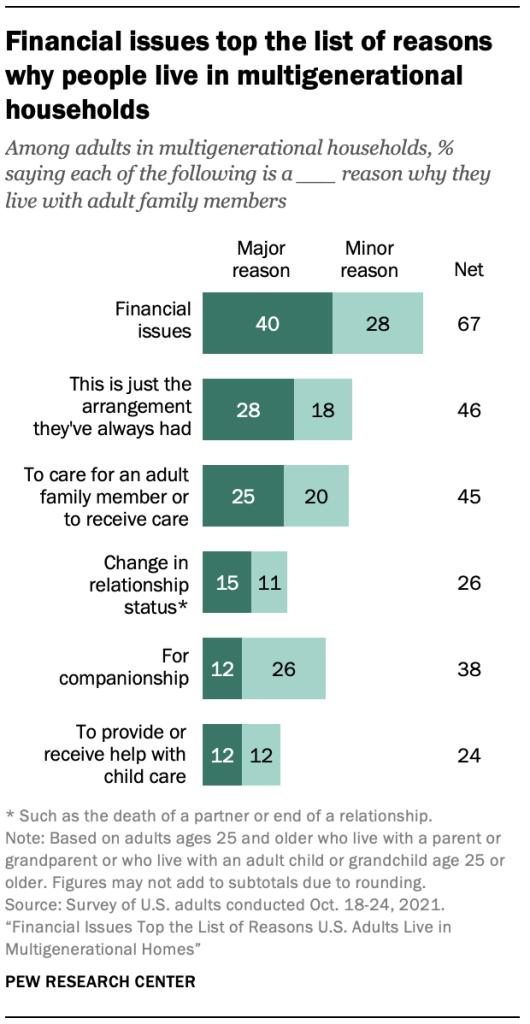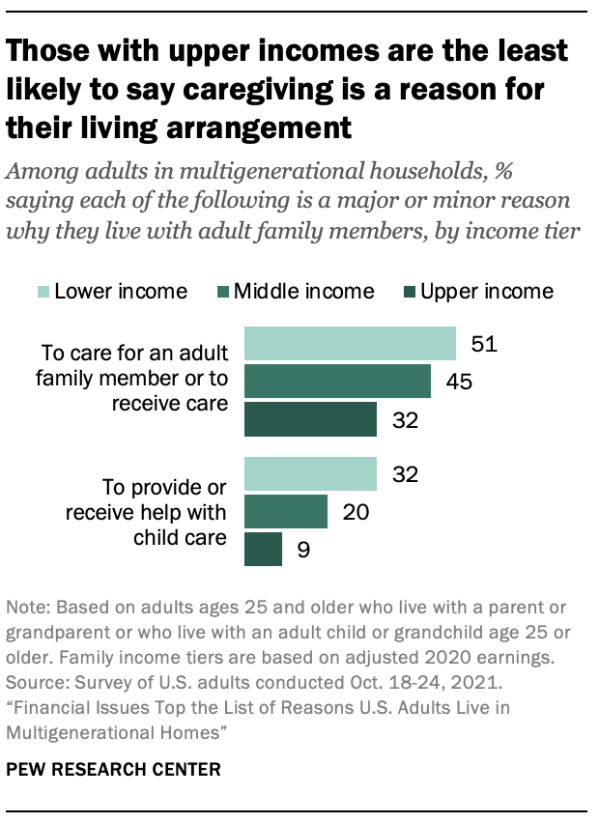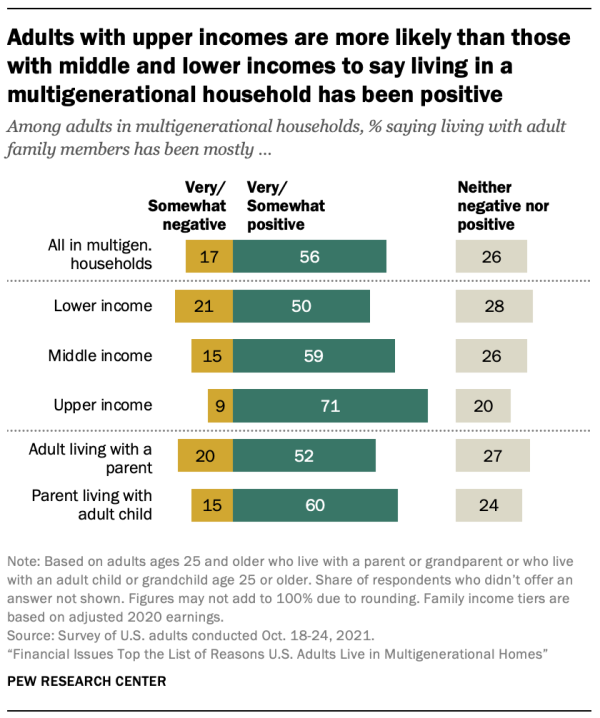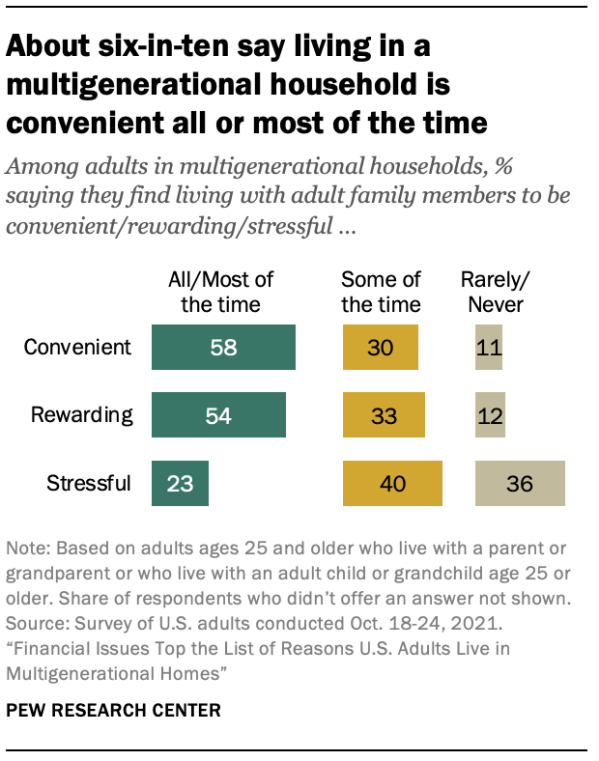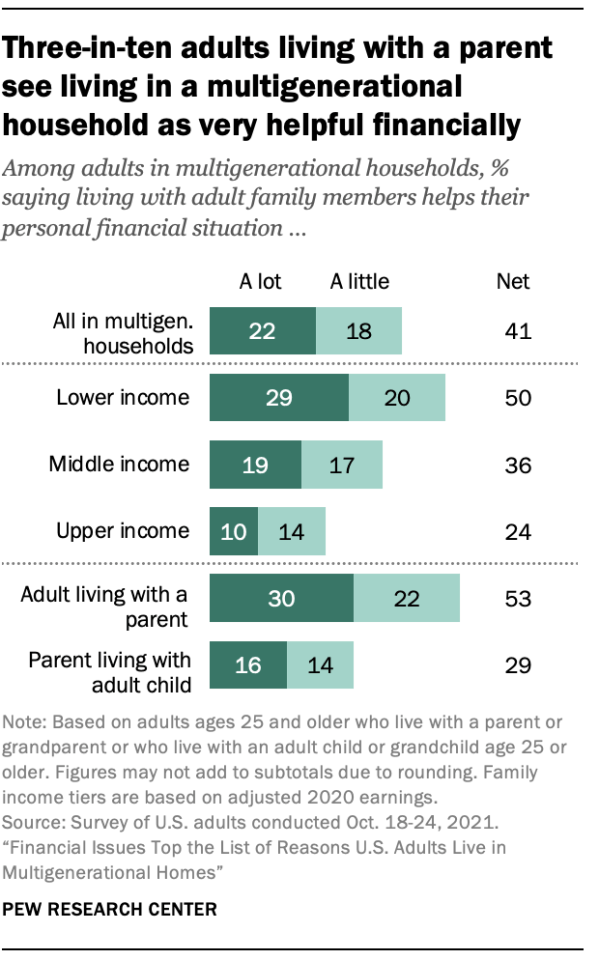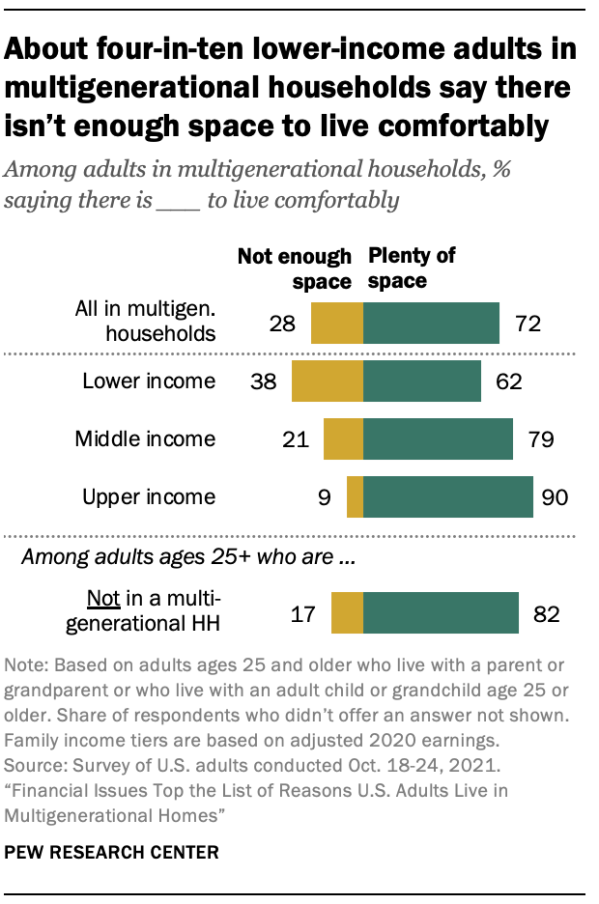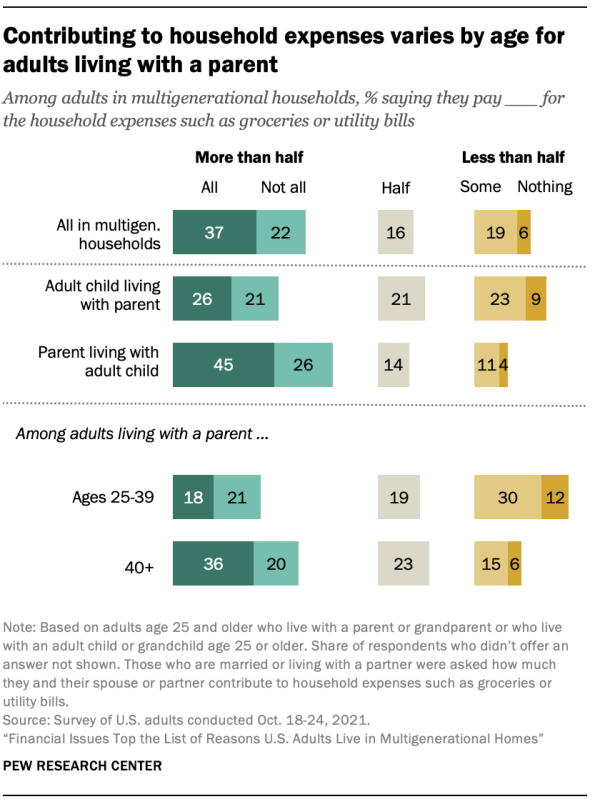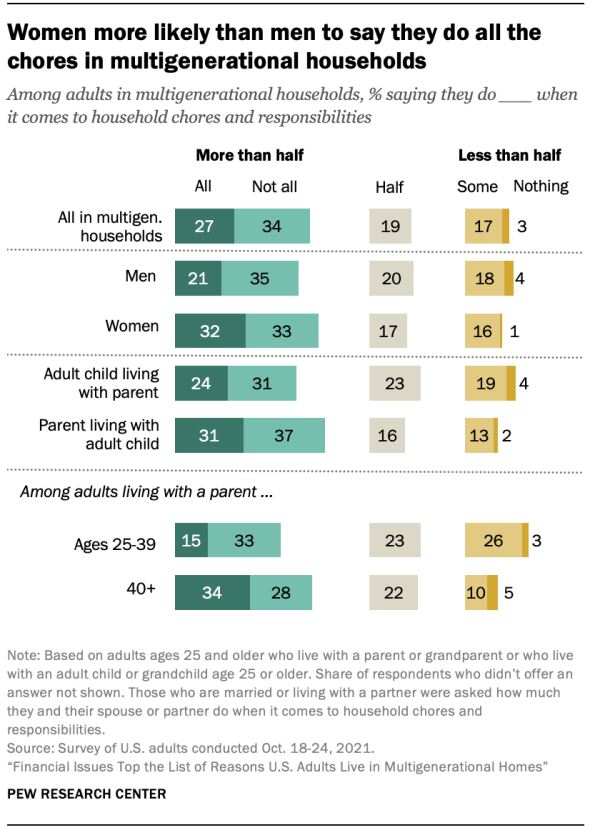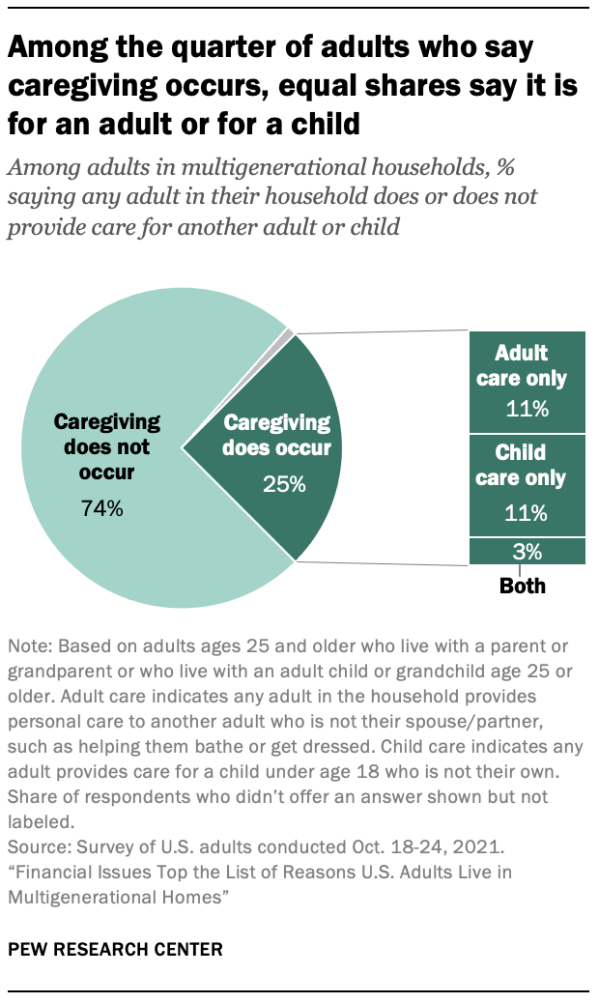There are a variety of reasons why adults live in multigenerational households, but financial considerations top the list.3 Many also say that this is just the arrangement they’ve always had or that caring for an adult family member or receiving care is a reason for their living arrangement. Relatively few say the reasons they live in a multigenerational household are related to the COVID-19 pandemic.
While a majority of adults in multigenerational households say caregiving, either for an adult or a child, is a reason for their living arrangement, a quarter say caregiving is, in fact, occurring in their household. Those with lower and middle incomes are more likely than upper-income adults in these households to say this is the case.
For the most part, adults living in multigenerational households say this has been a positive experience, with at least half saying their arrangement is often convenient and rewarding. Still, about a quarter say living with other adult family members can be stressful all or most of the time, and this is particularly the case among adult children living with a parent.
The experiences of adults in multigenerational households often vary by income; and, among adult children living with a parent, by age. For example, those with lower incomes are more likely than those with middle and upper incomes to say there’s not enough space to live comfortably. Younger adults (ages 25 to 39) who are living with a parent are much more likely than those ages 40 and older to see financial benefits in the arrangement and much less likely to say they contribute anything toward the mortgage or rent in their household.
Four-in-ten adults in multigenerational households cite financial issues as a major reason for their living arrangement
Four-in-ten adults in multigenerational households say financial issues are a major reason why they live with adult family members other than a spouse or partner; another 28% say this is a minor reason. Similar shares across racial, ethnic and income groups cite financial issues as a reason why they live in a multigenerational household.
About three-in-ten (28%) cite the fact that this is just the arrangement they’ve always had as a major reason for living in a multigenerational household, while a similar share (25%) say caring for an adult family member or receiving care themselves is a major reason. Smaller shares say each of the following is a major reason for their living arrangement: a change in their relationship status, such as the death of a partner or the end of a relationship (15%), for companionship (12%), or to provide or receive help with child care (12%).
The degree to which caregiving arrangements are tied to multigenerational living differs by income. Adults with lower and middle incomes are more likely than those with upper incomes to say caregiving is at least a minor reason why they live in a multigenerational household. About half of lower-income adults (51%) and 45% of those with middle incomes say caring for an adult family member or receiving care themselves is a reason, compared with 32% of those with upper incomes. And while 32% of those with lower incomes say providing or receiving help with child care is a reason why they live with other adult family members, 20% of those with middle incomes and an even smaller share of those with upper incomes (9%) say the same.
Among adults who are living with a parent, reasons for living in a multigenerational household vary considerably by age. Some 57% of younger adults (those ages 25 to 39) who live with a parent say financial issues are a major reason why; 31% of those ages 40 or older say the same. In turn, half of adults ages 40 and older who live with a parent say caring for an adult family member or receiving care is a major reason, compared with only 19% of those in the younger group. Adults ages 40 and older who are living with a parent (23%) are also more likely than those younger than 40 (11%) to say a change in relationship status, such as the death of a partner or the end of a relationship, is a major reason for their living arrangement.
For the most part, men and women who live with a parent give similar reasons for why they live in a multigenerational household, but men are more likely than women to say this is the arrangement they’ve always had (36% of men vs. 25% of women who live with a parent cite this as a major reason), while women are more likely than men to say a change in relationship status is a major reason (22% vs. 11%).
About one-in-eight adults in multigenerational households cite the pandemic as a factor
Most adults in multigenerational households (86%) say none of the reasons why they live with adult family members other than a spouse or partner are related to the coronavirus outbreak, but 13% say the pandemic is a factor in their living arrangement. Among those with lower incomes, 16% say the coronavirus outbreak is a factor in why they live in a multigenerational household, compared with 9% of those with upper incomes; 12% of those with middle incomes say the same.
When it comes to adults who are living with a parent, 17% of those ages 25 to 39 say at least one of the reasons why they live in a multigenerational household is related to the pandemic; just 9% of those 40 and older say the same.
A majority of adults in multigenerational households say living with other adult family members has been a positive experience
Some 56% of adults in multigenerational households say living with adult family members (other than their spouse or partner) has been at least somewhat positive, with 30% saying it has been very positive; 17% say it has been negative, while 26% see it as neither positive nor negative.
Assessments are particularly positive among those with upper incomes. About seven-in-ten upper-income adults in multigenerational households (71%) say their living arrangement has been at least somewhat positive, compared with 59% of those with middle incomes and 50% of those with lower incomes. About one-in-five lower-income adults in these households (21%) say their experience has been at least somewhat negative; smaller shares of those with middle and upper incomes say the same (15% and 9%, respectively).
Parents who are living with an adult child (60%) are more likely than adults who are living with a parent (52%) to say their experience has been at least somewhat positive. Among adults living with a parent, younger adults (ages 25 to 39) are much less likely than those ages 40 and older to say living in a multigenerational household has been at least somewhat positive (43% vs. 64%, respectively).
At least half find living in a multigenerational household convenient and rewarding, but some say it is stressful
About six-in-ten adults in multigenerational households (58%) say they find living with adult family members other than a spouse or partner to be convenient all or most of the time; 54% say it is rewarding. Still, roughly a quarter (23%) find living in a multigenerational household to be stressful all or most of the time.
Similar shares of parents living with an adult child and adults living with a parent say living in a multigenerational household is convenient or rewarding, but adult children are more likely than parents to say their living situation is stressful all or most of the time. About three-in-ten adult children living with a parent (31%) say this, compared with 18% of parents living with an adult child.
When it comes to the shares who find living in a multigenerational household to be convenient or rewarding, there are some differences by gender and age. Mothers who live with an adult child are more likely than fathers in this situation to say living in a multigenerational household is convenient (64% of mothers vs. 44% of fathers) and rewarding (60% vs. 47%) all or most of the time. While there are no similar gender differences among adults living with a parent, there are age differences in the shares saying their living situation is rewarding all or most of the time: 64% of those ages 40 and older say this, compared with 44% of those ages 25 to 39.
Half of lower-income adults in multigenerational households see financial benefits in their living arrangement
While financial issues are widely cited as a reason for living in a multigenerational household, adults with lower incomes are particularly likely to say this type of living arrangement is helpful to them financially. Half of lower-income adults in multigenerational households say living with adult family members other than a spouse or partner helps them financially at least a little, including 29% who say it helps a lot. Among those with middle incomes, 36% say living in a multigenerational household is helpful financially, while an even smaller share of those with upper incomes (24%) say the same. Overall, 22% of adults in multigenerational households say living with other adult family members helps their finances a lot and another 18% say it helps a little.
Adults living with a parent are far more likely than parents living with an adult child to say being in a multigenerational household helps them financially. Some 53% of adults who live with a parent say this helps their personal financial situation at least a little, with 30% saying it helps a lot. Younger adults living with a parent are more likely than those ages 40 and older to say their living arrangement helps a lot (37% vs. 23%).
Among parents living with an adult child, just 29% say their living arrangement helps their personal finances, including 16% who say it helps a lot. About three-in-ten parents who live with an adult child (28%) say their living arrangement hurts their personal finances at least a little, compared with 17% of adults who live with a parent that say the same.
Upper-income adults in multigenerational households are more likely than those with lower incomes to see their living situation as temporary
A plurality of adults in multigenerational households (41%) say their living arrangement is a long-term situation; 34% see it as temporary, and 24% say they don’t know. Upper-income adults in these types of households (47%) are more likely than those with middle (35%) and lower (31%) incomes to say this is temporary. Those with lower incomes express more uncertainty than those with middle or upper incomes: 28% of lower-income adults in multigenerational households say they don’t know if their living situation is temporary or long-term, compared with 21% of those with middle incomes and 17% of those with upper incomes.
Among adults living with a parent, assessments vary widely by age. A majority of those ages 40 and older (66%) say living in a multigenerational household is a long-term situation, while just 15% say it’s temporary and 19% say they don’t know. By contrast, about half of 25- to 39-year-olds living with a parent (49%) say their living situation is temporary; 30% see it as long-term and 20% don’t know. Overall, 47% of adult children living with a parent say their arrangement is long-term, compared with 38% of parents living with an adult child.
Most adults in multigenerational homes say there is plenty of space in their home
About seven-in-ten adults who live with adult family members other than a spouse or partner (72%) say there is plenty of space to live comfortably in their home, but assessments vary considerably across income tiers. Nine-in-ten of those with upper incomes say there is plenty of space to live comfortably, compared with 79% of those with middle incomes and 62% of those with lower incomes.
The survey also asked this question of adults ages 25 and older who do not live in a multigenerational household. An even larger share among this group (82%) say there is plenty of space in their home to live comfortably, while 17% say this is not the case (28% of adults in multigenerational households say there isn’t enough space to live comfortably).
Contributing to expenses, chores and caregiving in multigenerational households varies by household arrangement, age
Half of adults in multigenerational households say they pay more than half of the rent or mortgage where they live, including 39% who say they pay for all of it.4 In turn, 36% say they pay less than half of the rent or mortgage for their household, including 26% who say they don’t pay any of it. Some 14% say they pay half.
A majority of parents living with an adult child say they pay more than half of the rent or mortgage, including 51% who say they pay all of it. About a quarter (26%) say they pay some but less than half or don’t pay anything.5 In contrast, only about a third of adult children living with a parent say they pay more than half of the rent or mortgage, with 25% saying they pay all of it. Some 43% say they pay some but less than half (13%) or don’t pay anything (30%).
The extent to which adults living with a parent contribute to the rent or mortgage varies considerably by age. Among those ages 25 to 39, 37% say they don’t pay any of the rent or mortgage; about a quarter of those ages 40 and older (23%) say the same. In turn, about twice as many of those ages 40 and older say they pay all of the rent or mortgage compared with those ages 25 to 39 (35% vs. 16%).
There are also income differences in reported contributions to the rent or mortgage. Three-in-ten adults with lower incomes say they don’t pay any of the rent or mortgage, compared with 23% of middle-income and 20% of upper-income adults. Upper-income adults (68%) are more likely to say they pay all of the rent or mortgage than those with middle (47%) or lower incomes (26%).
The survey also asked respondents about their contributions to household expenses such as groceries and utility bills. About six-in-ten adults in multigenerational households say they pay for more than half of the household expenses; this includes 37% who say they pay for all of these expenses. A quarter say they pay less than half, with 6% saying they don’t pay anything. Another 16% say they pay half of these expenses.
Most parents living with their adult children say they pay more than half (26%) or all of the household expenses (45%). The responses from adult children living with a parent demonstrate more of a range in contributions: 26% say they pay all of the household expenses, 21% say they pay more than half but not all, 21% say they pay half, and 23% say they pay for some but less than half of these expenses. About one-in-ten of these adults (9%) say they don’t pay any of these expenses.
These contributions also vary by age: adults ages 40 and older living with a parent are more likely to say they pay all of the household expenses compared with those ages 25 to 39 (36% vs. 18%). Adults under 40 in these households are about twice as likely as those 40 and older to say they pay some but less than half or don’t pay any of the household expenses (42% vs. 20%).
While similar shares of adults across income tiers say they don’t pay any of the household expenses, those with upper incomes (59%) are more likely than those with middle (44%) and lower incomes (26%) to say they pay for all of them.
Women more likely than men in multigenerational households to say they cover more than half of the household chores and responsibilities
Many people contribute to their multigenerational households beyond paying for expenses, with 61% of adults in these households saying they do more than half of the household chores and other responsibilities, including 27% who say they do all of them. About one-in-five (19%) say they do half, and a similar share say they do less than half (17%) or don’t do any (3%).
A majority of parents living with an adult child say they do more than half of the chores, including 31% who say they do all of them. This compares with 54% of adults living with a parent who say they do more than half of the chores, with about a quarter saying they do all of them. About one-in-five of those living with a parent (22%) say they do less than half or none of the chores.
Again, these contributions vary by the age of the adult living with a parent. Those ages 40 and older (34%) are about twice as likely as their counterparts under age 40 (15%) to say they do all of the chores. And while about three-in-ten of those ages 25 to 39 (29%) say they do less than half or none of the chores, just 14% of those in the older group say the same about their contributions to household chores.
Women in multigenerational households are more likely than their male counterparts to say they do more than half or all of the household chores and responsibilities. Two-thirds of women (66%) say this, compared with 56% of men. Men ages 25 to 49 are the least likely to say they do more than half or all of the chores (44% vs. 59% of women in the same age group and about seven-in-ten men and women ages 50 and older, 68% and 69%, respectively).
A quarter of adults say caregiving occurs in their multigenerational household
About one-in-ten adults in multigenerational households (11%) say an adult provides personal care for another adult in the household who is not the caregiver’s spouse or partner; the same share say an adult provides care for a child under age 18 in the household who is not their own.6 Some 3% of adults in multigenerational households say care occurs for both an adult and child in their household.
The share who say caregiving occurs in their household varies by income. Adults with lower (30%) and middle incomes (24%) are more likely than those with upper incomes (15%) to say caregiving occurs in their household. When asked if they personally provide care for a child younger than 18 who is not their own in the household, lower- and middle-income adults are more likely than upper-income adults to say they do this at least sometimes (16% and 11% vs. 3%); similar shares across income groups say they personally provide adult care at least sometimes.
Men and women in multigenerational households are about equally likely to say they personally provide child care for a child in the household who’s not their own at least sometimes. Among men, 15% say they provide personal care for another adult in the household; 10% of women say they do this.
About one-in-five adults living with a parent (18%) say they personally provide care for another adult who is not their spouse or partner in the household at least sometimes. This compares with 11% of parents living with an adult child who say they personally provide care for another adult at least sometimes.
Adults living with a parent age 65 or older are especially likely to say they personally provide care for another adult in their household: about a quarter (23%) say they do this at least sometimes, compared with 8% of those living with a parent under 65.


